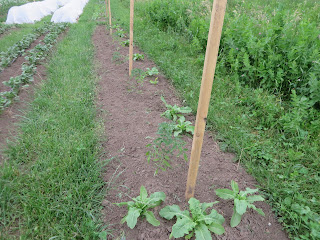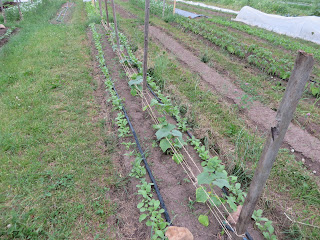Update July 20th:
The fingerling potatoes are harvested. Looking very good. Fingerlings are typically small tubers, but don't let that put you off. They are considered to be the most flavorful of all potato types. The skin is very thin, so don't waste your time peeling them.
The garlic is harvested. The plants are healthy, but the bulbs are unusually small.
Important - added delivery dates, confirmed farm visit dates:
As indicated on this site earlier this season, I have added two delivery dates.
August 29th.
September 26th.
I have reserved some time for scheduled farm visits for the weeks of
August 1st
August 15th
More details regarding farm visits to be posted soon.
 I hope that the last few deliveries have sufficiently whetted your appetites. More crops are now coming in and we can expect larger deliveries from now until season's end.
I hope that the last few deliveries have sufficiently whetted your appetites. More crops are now coming in and we can expect larger deliveries from now until season's end.I am especially looking forward to the tomatoes and peppers - the plants are just starting to set their flowers.
Some plants have set their first fruits, these are candidates for seed saving.

Water saving techniques - I hoe a shallow trench around the squash plants to capture rainfall and mulch over it to reduce evaporation.
The irrigation system helps somewhat, though these deep rooted plants do best when planted in areas of the field with a shallower water table.
Until the irrigation system is extended to this new area of the field, I water by hand.
The straw also helps protect the fruits from rotting due to contact with the soil.
 As I have written elsewhere, an irrigation system running for a week will not provide as much water to the crops as a twenty minute period of gentle rain.
As I have written elsewhere, an irrigation system running for a week will not provide as much water to the crops as a twenty minute period of gentle rain.Likewise, a trace amount of precipitation can soak into the ground a lot more thoroughly when the ground is already wet from the irrigation system.
A few notes about this week's lettuce:
I'll start by reserving my own judgment on the quality until the end of this post.
In previous years, I composted some lettuce that I felt was substandard. The growth was there, but the leaf quality sometimes seemed a bit tough.
On one occasion, a pick-up customer noticed the basket of rejected heads set aside and inquired if that was extra. I explained, she requested a sample, took a bite and declared there was nothing wrong with it.
I delivered some similar lettuce late last season (recall the weather was quite dry here in September?) and then referred to this in last years customer survey. Most respondents claimed the lettuce was good; one noted that it was "...a bit bitter in salads but great for sandwiches."
Last Friday as I checked the crops for forthcoming harvest, I observed that the lettuce leaves seemed a bit tough, presumably due to lack of water. With rain predicted for Saturday and or Sunday, I decided that the precipitation would give the plants enough moisture to soften up.
We were away on a farm search on Saturday; when we stopped at the farm that evening to close the hardening off shelter, I checked the rain gauge and found only a trace amount had fallen. More rain appeared imminent (indeed, we drove through some on our way to Kanata) and I thought no more of it.
Sunday I was at the farm and it showered lightly a few times. By the time I was closing up, a heavy cloud and rain curtain was a few kilometers north, and the wind was bowing from that direction. I closed up and left, glad that finally there would be enough water to soak the ground.
 Upon my return Monday, the rain gauge indicated less than half an inch had fallen all day Sunday and Sunday night - the heavy rain must have passed the farm (the photo here shows a similar event a few years ago).
Upon my return Monday, the rain gauge indicated less than half an inch had fallen all day Sunday and Sunday night - the heavy rain must have passed the farm (the photo here shows a similar event a few years ago).By Tuesday morning, it was apparent that the rain had not penetrated very far; a quick finger test indicated that most beds were quite dry below the surface.
Had I turned on the irrigation the previous Friday evening and left it on for 48 hours, what little precipitation that fell would have soaked into the soil more thoroughly - soil saturates one layer at a time - and thus what we received would have penetrated deeper.
What does this have to do with the lettuce?
In my opinion, this week's lettuce is tough not crispy. The flavor is strong, though typically (again, my opinion) lettuce ought to have a strong, slightly bitter flavor - hence my preference for red leaf lettuces and my disdain for iceberg. Overall, I was disappointed.
However, I kept reminding myself about the pick-up customer and positive results from the survey and concluded that it was better to deliver this then to let it go to the compost to turn into next years food.
My thoughts were the same for the endive, I like the flavor, but think it is a little too strong and probably too tough.
It has been a few years since I have grown endive. Shortly after transplant this season, I realized this variety is different than what I have grown in the past as well, so I don't have anything to reference it to (the endive I grew back in 2013 had much smaller leaves, with a tightly bunched and slightly blanched heart.
Should I have assume that the rain was not going to come? I had every indication to believe it would...
Just to be absolutely certain, I got the irrigation on yesterday in spite of rain in the forecast; hopefully the lettuce growing now will be in better shape next harvest - July 11th.

























